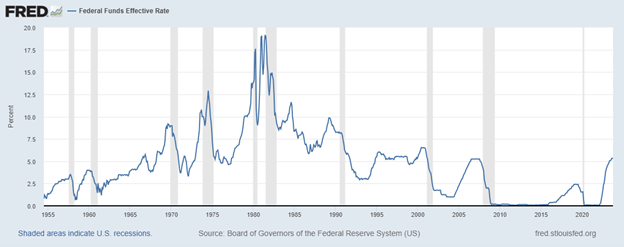The Fed Leaves Interest Rates Unchanged – Here’s What to Do Next Dear Reader, Investors took a short break from earnings season to turn their attention to yesterday’s highly anticipated November Federal Open Market Committee (FOMC) meeting.
As expected, the Fed stood pat and left key interest rates unchanged in November. So, the federal funds rate still stands between 5.25% and 5.50%. They also remain at their highest levels since 2001. You can see for yourself in the chart below. 
But what really had investors excited was the dovish FOMC statement. The Fed acknowledged that the runup in long-term Treasury rates is now weighing on economic activity. Specifically, it stated, “Tighter financial and credit conditions for households and businesses is likely to weigh on economic activity, hiring, and inflation. The extent of these effects remains uncertain.”
The Fed also acknowledged that inflation is still elevated but also did its best doublespeak and admitted that inflation is cooling.
Wall Street cheered the FOMC statement, driving the S&P 500 and NASDAQ up more than 1% and the Dow up 0.7% yesterday. This tells me that Wall Street has decisively decided that the Fed is now done raising rates, which I am also in complete agreement with. The pressure is now going to mount on the Fed to cut rates. The reality is that the Fed needs to lower interest rates; the high rates are killing the U.S. economy. So, in today’s Market 360, we’ll consider what was behind this year’s rise in Treasury yields and a sector they hurt.
Now, since the Fed’s interest rate decision yesterday, Treasury yields have turned lower. So, we’ll also talk about what to expect from the market if they continue to fall… and how investors can best profit. The U.S. Federal Budget Deficit Drives Up Yields There is no doubt that the record U.S. federal budget deficit of $1.695 trillion in fiscal year 2023 put upward pressure on Treasury bond yields. The Wall Street Journal reported that a $333 billion spending cut attributable to the Supreme Court’s cancelation of student debt loan relief means that the real federal government budget deficit for fiscal year 2023 was actually well over $2 trillion.
Looking forward, the U.S. deficit is expected to get much worse, especially as the federal government throttles up funding for another war in the Middle East. I should add that the International Monetary Fund (before the flare up in the Middle East) projected a 7.4% deficit for the U.S. in fiscal 2024, which is substantially higher than a 2.7% deficit projection for 2024 for the eurozone.
Ironically, Treasury Secretary Janet Yellen said that the surge in long-term Treasury bond yields is a reflection of a strong U.S. economy, not the jump in government borrowing that is driving high federal budget deficits.
Specifically, Yellen told Bloomberg that “I don’t think much of that is connected” to the federal budget deficit. She also added that “We’re seeing yields go up in most advanced countries.” Yellen concluded by saying the increase in yields are “largely a reflection of the resilience people are seeing in the economy.”
The reality is the high yields are hurting the economy, and we need look no further than what’s happened to the manufacturing sector for proof…
Yesterday, it was reported that the Manufacturing PMI index dropped to 46.7 in October, down from 49.7 in September. This means that the manufacturing sector has been down for 12-straight months now. New orders dropped to 45.5, which is down sharply from 49.7 in September. Also notable is that the backlog of orders component was only 42.2. Anything below 50 signals a contraction, so this is a big problem. Falling Yields Are Good for Stocks As I mentioned, yields are moving back down. As of this writing, the 10-year Treasury yield is at about 4.67% after coming just shy of 5% last week. The 30-year Treasury yield is also back below 5%, while the two-year Treasury yield is hanging around 5%.
And as Treasury yields are falling, stocks are rising. Today, the S&P 500, Dow and NASDAQ surged more than 1%. The even better news is stocks should continue to rally as Treasury yields and rates meander lower.
So, if you’re not invested in the market, now is the time to jump in. But you don’t want to invest in any stock, you want to focus on those with superior fundamentals . Remember, we’re still in the midst of the third-quarter earnings season, which is when a company’s fundamentals take center stage. The third-quarter earnings season has already been characterized by a slew of better-than-expected earnings results. In fact, FactSet reports that the S&P 500 should now post 2.7% average earnings growth for the quarter, up from previous estimates for a 0.3% drop in earnings growth.
I still expect third-quarter earnings announcements to dropkick and drive many stocks higher, especially my Growth Investor stocks. My current Buy List stocks remain characterized by 160.8% annual earnings growth and have benefited from a 7% increase in analysts’ estimates over the past three months. So, wave-after-wave of positive earnings surprises should drive even more investors to my fundamentally superior stocks and send them soaring.
I should also add that right now, my Growth Investor stocks trade at 14.6 times median forecasted earnings. As strong third-quarter earnings come out, price-to-earnings ratios will be compressed further. In addition, my average Growth Investor stock has raised its dividend 37.1% in the past 12 months. As a result, the foundation under my Growth Investor stocks remains strong and is growing stronger.
The bottom line: Thanks to the Fed, we now have a major market rally brewing. If you want to profit from it, then invest in fundamentally superior stocks.
(Already a Growth Investor subscriber? Click here to log in to the members-only website.)
Sincerely, |
.png)
.png)






ليست هناك تعليقات:
إرسال تعليق